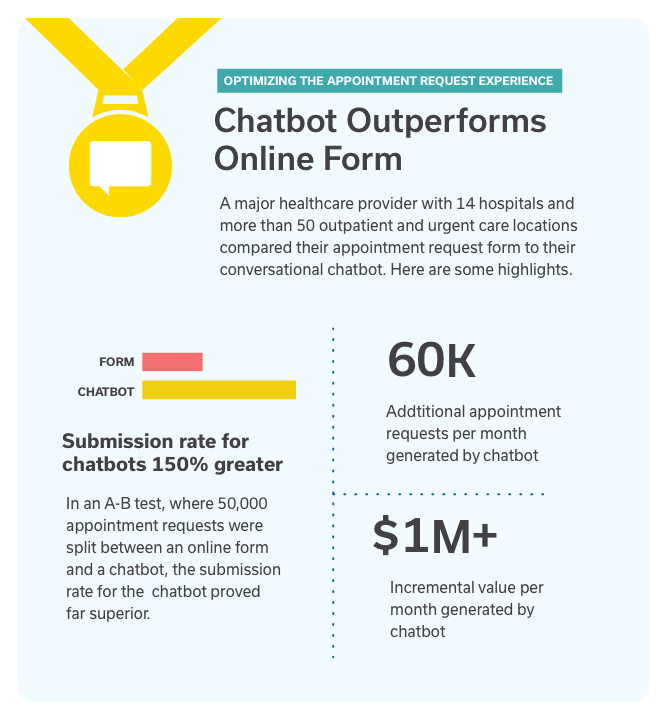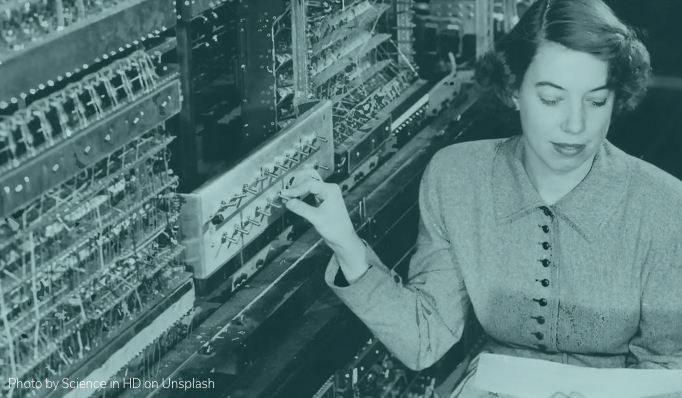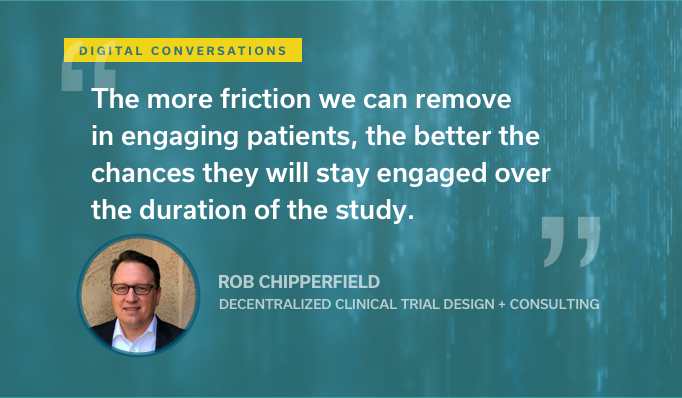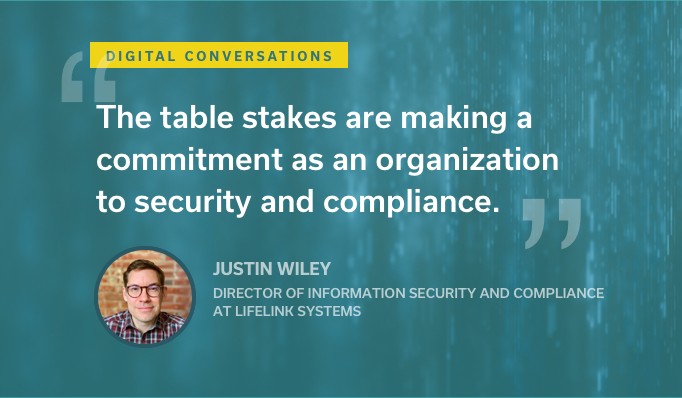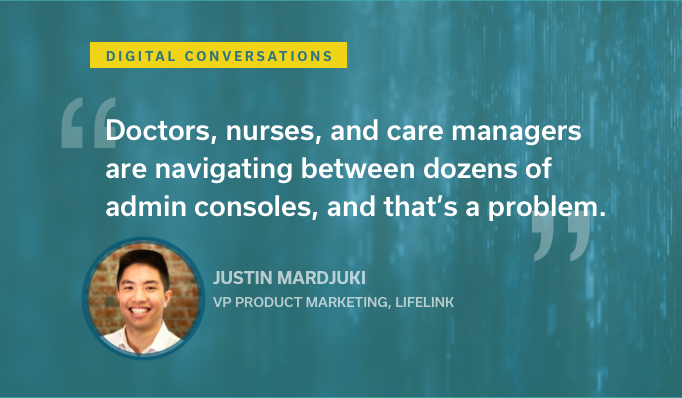Imagine you’re shopping for a new set of earbuds online. You do a Google search on your smartphone, maybe you hit Amazon and Best Buy for options, read some reviews, make your choice, and locate the killer Black Friday deal. Now what?
If you’re like most consumers, the days of waking up at 4am on a frigid November morning and heading down to the local mall to wait in line with 200 other crazed shoppers are over. Instead, you grab your phone, locate the deal and with a few simple swipes and clicks those earbuds are all set to arrive at your front door the next day.
That, my friends, is a modern consumer experience. That’s the bar.
Amazon alone processes $283,000 worth of transactions every second. On Black Friday 2019, once the domain of bricks and mortar shopping, shoppers spent $7.2 billion online. And they’re using their phones to handle the transactions. In 2018, mobile sales accounted for nearly 40% of all retail ecommerce sales in the US.
Retailers are nowhere close to being done innovating. It’s an arms race to make things as convenient for consumers as possible — drones, next hour delivery, instant rewards programs, and voice tech (order without lifting a finger!) are well past planning stages and will be part of the everyday consumer experience before you know it.
Brick and mortar retail is not fighting for survival because of high prices, or not having enough inventory. The core issue is convenience, which is fueled by automation on the powerful, connected mobile devices that we all carry in our pockets.
Consumer-Centric Healthcare Shopping Experiences
Hardly a day passes where there isn’t a healthcare news story or new event agenda focused on consumerism and modern patient experience. Healthcare industry leaders talk about it constantly. Everybody gets it. Doing Black Friday shopping on Amazon is superior to battling crowds and healthcare should strive to get into that sandbox.
Consumerizing healthcare isn’t as easy as launching an updated ecommerce app or new loyalty program. Healthcare has unique challenges — wrangling multiple systems of record, thousands of disparate providers, and dozens of unique sites and hospitals that make up a hospital system is no joke. Hospital tech teams are tackling problems like interoperability and data access head on, spending countless hours and billions of dollars developing the back end infrastructure that will make killer consumer experiences a reality. You can read all about it here.
However, consumers and their ever-growing expectations don’t have the patience for the industry to reach interoperability nirvana. Thousands of consumer brands are constantly “training” patients and raising the bar on what’s possible when it comes to engaging with any kind of business or service. Layer on the reality that Amazon, Walmart, Apple, and Best Buy are all moving into healthcare and the level of urgency rises even higher. Consumer companies will find ways to raise the patient experience bar because they’re built to run at a higher level. They’re not going to lower their standards and go backward.
Healthcare organizations need to pick their spots — quickly — where they can show patients they can deliver consumer-friendly experiences just like their favorite retailers.
Going Digital to Make Appointments
One dimension of the healthcare experience that gets close to buying earbuds on Amazon is finding a doctor and scheduling an appointment online. If you have a bad sinus infection and want to get a prescription of amoxicillin, or need to see a dermatologist for a skin rash, wouldn’t it be nice to go online and get everything set without waiting on hold and talking to an agent? Even the DMV has that capability, yet hospitals are still behind.
Some aggregators like Zocdoc have introduced patients to an OpenTable-like experience for booking appointments. However, most hospitals still rely on a 1-800 strategy for setting appointments. Based on a random survey of 97 large US hospitals, we discovered that only 28% of hospitals offer an online appointment request capability via their websites.
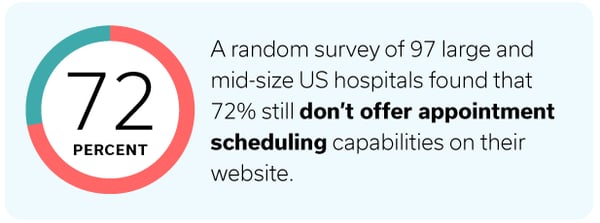
Online forms may be a step in the right direction, but are far from an advanced Amazon-like experience and a full decade behind other industries. One of the hospitals we examined required patients to complete 114 form fields to make an appointment. And 97% of the hospitals surveyed do not have an appointment workflow that includes “book now” self-scheduling capabilities.
Websites and mobile apps are still part of the mix, but a new class of engagement tech has emerged and it’s conversational. Clunky form fields and drop down menus are being outperformed by virtual assistants that interact with customers through natural conversational flows — voice and text messaging.
Often referred to the digital front door experience in healthcare, the ability to turn a hospital website from a flashy brochure to an easy on-ramp to hospital services is a top priority for marketing leaders, with appointment scheduling being among the top priorities. Conversational virtual assistants — the same bots that pop up on websites asking if you need help — are part of the vision.
“Can I Help You?” is Not Enough
Today, it’s not uncommon to have a chatbot appear on the lower right corner of a website home page. These bots are designed to improve lead conversion by engaging visitors in a conversation, collecting additional information and then directing visitors to the right agent or channel to close. These bots have proven to be very effective and are a sign that 800 numbers and online forms may be on the way out. Spend ten minutes surfing some big brand websites and you will see them.
Lead generation bots could be an effective solution for request doctor appointments. They are always on, they engage, they collect information in the context of a better patient experience. They’re like having 24/7, on-demand access to a Patient Access specialist. But unlike retail where the purchasing the earbuds is a one-and-done transaction, an appointment with a doctor is frequently the beginning of an extended relationship with a health system.
A patient sees the doctor, then gets a prescription and a referral to a specialist. From there, patients many need follow up appointments, labs, surgery, physical therapy and so on. Shouldn’t that virtual assistant follow the patient all the way?
The lights out, bad-ass chatbot for healthcare will blend the seamless front-end engagement capabilities of the best website assistants with a series of robust capabilities (including deep EMR integration) to help patients navigate a complex healthcare experience that could go on for days, or weeks, or even years. In some ways it is the equivalent of the earbud mobile order assistant arranging shipping, confirming delivery, and checking in with the shopper about sound quality a month later.
It’s important to remember that patients are paying for more of their health care and are in a position to shop around more than ever before. A great digital front door experience will become a key battleground to invite patients into hospital systems. And, to do it at scale 24x7, marketers must offload a majority of inbound inquiries so highly-trained, expensive call center teams can focus on the high impact, complex engagements.
The healthcare virtual assistant bot that helped you set your MRI appointment can even remind you to bring your new earbuds so you are entertained while the MRI machine is scanning. Now we’re talking!
